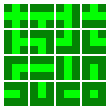Sztuczna inteligencja
Wyniki egzaminu oraz zestaw z egzaminu
Skrypt w ktorym znajdują się opisy wszystkich omawianych ćwiczeń.
Skrypt w ktorym znajdują się opisy wszystkich omawianych ćwiczeń.
Wykład
- 2015-09-30
Czym jest sztuczna inteligencja (materiał do Testu Turinga).
Summary
In this part we covered the following concepts:- different definitons of inteligence (natural, not artificial)
- characteristic of inteligence (ability to learn, gain knowledge, make conclusion and generalize)
- strong and weak artificial inteligence
- 2015-10-07
Czym jest sztuczna inteligencja (materiał od Testu Turinga do końca).
Czy maszyny mogą myśleć - rozważania na temat silnej sztucznej inteligencji, praca magisterska p. Urszuli Jędrzejczak
Summary
In this part we covered the following concepts:- Turing test
- Searle's Chinese room
- Churchland's luminous room
- 2015-10-14
Solving problems by searching (do sformułowania prostych problemów - sformułowania omawiać będziemy na następnych zajeciach)
Summary
In this part we covered the following concepts:- world state;
- what does it mean when environment is observable, discrete, known, deterministic;
- what does the formulate--state--execute design pattern for the agent mean;
- define and explain all the components defining problem;
- what the solution is;
- explain validity and usefulness of the abstraction used while working on the problem.
- 2015-10-21
Solving problems by searching (do depth-first search włącznie)
Summary
In this part we covered the following concepts:- know how to describe some toy and non-toy problems in terms of state, initial state, actions, transition model, goal test, path cost;
- what a search tree is;
- define and explain general tree-search algorithm;
- define and explain graph search algorithm;
- define and explain breadth-first search;
- define and explain uniform-cost search;
- define and explain depth-first search;
- explain differences between informed and uninformed search strategies;
- how we can measure problem solving performance.
- 2015-10-28
Solving problems by searching (pozostała część wykładu)
Introduction to A* (bardzo dobre)
Introduction to A* (nowa wersja poprzedniego z animacjami)
Summary
In this part we covered the following concepts:- explain the idea of informed (heuristic) search strategies;
- what a heuristic function is;
- define and explain best first search (in greedy and A* variant).
- 2015-11-04
Solving problems by searching (podsumowanie dotychczasowego wykładu; praca z przykładami)
Our graph
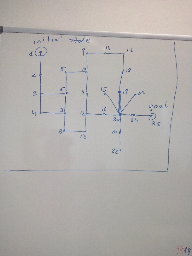
Breadth first search
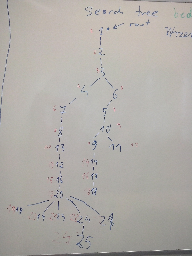
Deep first search
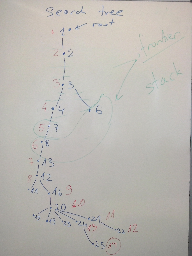
Uniform cost search -- I forgot to save it, sorry...
Greedy best first search

Best first search

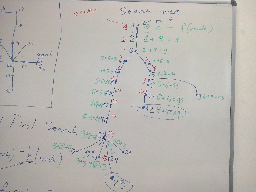
Summary
In this part we covered the following concepts:- know how to use the algorithms we have discussed so far for specific tasks.
- 2015-11-18
Beyond classical search (do algorytmu genetycznego włącznie)
Summary
In this part we covered the following concepts:- know examples of the problem with irrelevant path;
- know what is state-space landscape;
- know what is objective function;
- define and explain hill-climbing algorithm;
- know some possible variants of hill-climbing;
- define and explain simulated annealing algorithm;
- explain concepts related to genetic algorithms: population, individual, fitness function, selection, crossover, mutation
- define and explain genetic algorithm.
- 2015-11-25
Beyond classical search (ciąg dalszy - od searching in continuous space do and-or drzew włącznie)
-
- Metoda gradientowa - idea
- Metoda gradientowa - materiały z wykładu

- And-Or trees
- Transition table
- Tree
- Solution
- Simplified version of the above tree
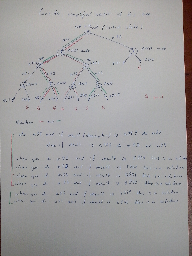
In this part we covered the following concepts:- know what is gradient;
- know how we can use gradient to find min or max of the objective function;
- know when and why we need contingency plan (strategy);
- know what is "or" and "and" node;
- define and explain and-or search algorithm.
-
- 2015-12-02
Beyond classical search (pozostała część wykładu)
Genetic algorithm - tips to exercise
Summary
In this part we covered the following concepts:- know what is belief state;
- know how to define sensorless problem;
- know how to define partially observable problem;
- know what is online search;
- define and explain an online depth-first search algorithm.
- 2014-12-09
Adversarial search (mini-max, mini-max z cięciami)

Przykład pokazując, iż wybór optymalnego ruchu zależy od głębokości analizy (dla głębokości 1 był to ruch A3, dla głębokości 2 - ruch A1 a dla głębokości 3 - ruch A2)
Przykład (Wikipedia) - dwa obrazki: statyczny pokazujący ideę oraz dynamiczny pokazujący co się dzieje
Intuicja pokazująca możliwość pominięcia niektórych gałązi
Summary
In this part we covered the following concepts:- why games are so interesting for AI (tip: games require the ability to make some decision even when calculating the optimal decision is infeasible while any inefficiency is penalize severely);
- how to define game as a search problem (define terms: initial state, transition model, terminal test, payoff function and functions: player, actions);
- what is an optimal solution in games;
- define and explain mini-max algorithm;
- explain how alpha-beta cutoff works.
- 2015-12-16
Learning from examples (drzewa decyzyjne)
Summary
In this part we covered the following concepts:- why we want an agent to learn;
- which agent's components can be learned;
- define / explain three main types of learning;
- what is a decision tree and how it works;
- define and explain decision tree learning algorithm.
- 2016-01-13
Sztuczne sieci neuronowe (czym jest sztuczny neuron) Summary
In this part we covered the following concepts:- a biological neuron - important "parts" and properties;
- an artificial neuron - how it imitate bilogical parts and functionality;
- activation function;
- basic networks architectures;
- basic properties of neural networks in terms of classification areas (blea and red regions).
- 2016-01-20
Sztuczne sieci neuronowe - ciąg dalszy (czym jest sztuczna sieć neuronowa, jej budowa itd)- Moje notatki (rozdział 15 i 16, strony 125 -- 157)
- Rozpoznawanie liter
- Gra czołg
- Kompresja obrazu fotka01.png fotka02.png fotka03.png fotka04.png fotka05.png fotka06.png fotka07.png fotka08.png
- Krzywe prostokat.png domek.png domek_z_k.png krzywa1.png krzywa2.png
- Sieć samoorganizująca
- Kompresja obrazu z wykorzystaniem sieci samoorganizującej
- Hopfield
- Podział płaszczyzny
- Perceptron Demo - symulacja procesu nauki prostej sieci
- Problem XOR
- XOR i wsteczna propagacja (demo)
- Rozkład obszarów atrakcji poszczególnych neuronów, gdy miarą odległości jest odległość euklidesowa
- Rozkład obszarów atrakcji poszczególnych neuronów, gdy miarą odległości jest iloczy skalarny
- Rozkład obszarów atrakcji poszczególnych neuronów, gdy miarą odległości jest iloczy skalarny a zbiór uczący jest znormalizowany
- Rozkład obszarów atrakcji poszczególnych neuronów, gdy miarą odległości jest odległość euklidesowa a zbiór uczący jest znormalizowany
- Moje notatki (rozdział 15 i 16, strony 125 -- 157)
Różne materiały uzupełniające
- Strategies and Tactics for Intelligent Search
- Algorithmic Thoughts (m.in. opis algorytmów przeszukiwania)
Ćwiczenia
Wysyłając pliki proszę stosować się do poniższych zasad:- Całe zadanie / projekt proszę wysyłać jako jeden plik będący archiwum zip.
- Nie używać dużych liter.
- Nie używać spacji tylko znak podkreślenia.
- Nie używać znaków narodowych, czyli np. ą, ć itd.
- Do numeracji używać zawsze dwóch cyfr najwyżej jako pierwsza będzie 'zero').
- Zachować format: nazwisko_imie_numer.rozszerzenie
| Numer | Nazwa projektu | Data zadania / Ostateczny termin oddania | Opis projektu | ||||||||||||||||||||||||||||||||||||||||||||||||||||||||||||||||||||||||||||||
|---|---|---|---|---|---|---|---|---|---|---|---|---|---|---|---|---|---|---|---|---|---|---|---|---|---|---|---|---|---|---|---|---|---|---|---|---|---|---|---|---|---|---|---|---|---|---|---|---|---|---|---|---|---|---|---|---|---|---|---|---|---|---|---|---|---|---|---|---|---|---|---|---|---|---|---|---|---|---|---|---|---|
| 1 | Puzzle | 2015-09-30 do końca semestru |
Projekt za 1pkt w wersji z puzzlami kwadratowymi i za 2 pkt z wersji z puzzlami prostokątnymi. |
||||||||||||||||||||||||||||||||||||||||||||||||||||||||||||||||||||||||||||||
| 2 | Rozpoznawanie znaków | 2015-10-08 2015-11-04 |
Projekt za 1pkt Napisać program rozpoznający znaki, tj. klasyfikujący podany znak do jednej z dwóch klas znaków. Przyjmijmy, że znak opisany jest przez mapę bitową o wysokości 7 pixeli i szerokości 5 pixeli. Użytkownik sam określa znaki tworzące każdą z klas. |
||||||||||||||||||||||||||||||||||||||||||||||||||||||||||||||||||||||||||||||
| 3 | Test Turinga, rozmowa z chatbotem | 2015-10-14 2015-10-21 |
Projekt za 1pkt Przeprowadź rozmowę z chatbotem. Spróbuj zdefiniować różnice pomiędzy botem udającym człowieka (przygotowywanym na test Turinga) a botem „asystentem, służącym”. Sprawdź boty ze względu na:
Zacząć możesz od następujących chatbotów, ale poszukaj też własnych: cleverbot.com www.chatbot4u.com www.chatbot.pl douweosinga.com chatterboty.pl www.chatbots.org www.personalityforge.com wellbot.tk www.inguaris.pl Akinator. The web genie |
||||||||||||||||||||||||||||||||||||||||||||||||||||||||||||||||||||||||||||||
| 4 | Przeszukiwania wszerz, w głąb oraz uniform-cost | 2015-10-21 2015-11-18 |
Mój przykładowy programLabirynty dla BFS i DFSOpis formatu pliku Wygląd pól labiryntu (numeracja pól zgodnie z opisem w skrypcie, na wszelki wypadek podaję obok)
Graf dla uniform-costOpis formatu pliku dla zadania unfiorm-costPlansza dla uniform-cost (a także dla BFS i DFS)Przykładowa plansza (bfs_citi_01.txt) i jej wygląd: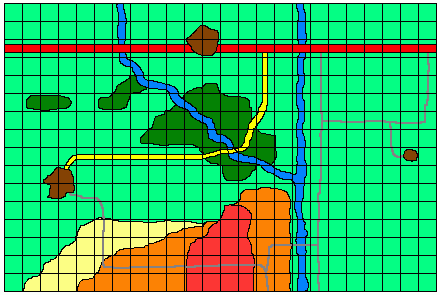 oraz proponowany koszt wejścia na pola:
|
||||||||||||||||||||||||||||||||||||||||||||||||||||||||||||||||||||||||||||||
| 5 | Best First Search (A*) | 2015-10-28 2015-11-25 |
Mój przykładowy programGrafy w przestrzeniOpis formatu plikuInneMożna użyć mapy z poprzedniego ćwiczenia. |
||||||||||||||||||||||||||||||||||||||||||||||||||||||||||||||||||||||||||||||
| 6 | Simulated Annealing | 2015-11-18 2015-12-02 |
ProblemWe want to minimize a simple function of two variables
min f(z) = (4 - 2.1*x^2 + x^4/3)*x^2 + x*y + (-4 + 4*y^2)*y^2;
z=(x, y)
 

 Wykres Solution
x = -0.0896
y = 0.7130
z = (x, y)
f(z) = -1.0316
Dodatkowe materiały |
||||||||||||||||||||||||||||||||||||||||||||||||||||||||||||||||||||||||||||||
| 7 | And-Or drzewa | 2015-11-25 2015-12-09 |
Data files, you can use to test yor program
|
||||||||||||||||||||||||||||||||||||||||||||||||||||||||||||||||||||||||||||||
| 8 | Genetic algorithms | 2015-12-02 2016-01-13 |
Solve task 6 with genetic algorithm Suggestion for coding:  Suggestion for crossover: 
|
||||||||||||||||||||||||||||||||||||||||||||||||||||||||||||||||||||||||||||||
| 9 | Mini-max i prosta gra | 2015-12-09 end of the semester |
|
||||||||||||||||||||||||||||||||||||||||||||||||||||||||||||||||||||||||||||||
| 10 | Drzewa decyzyjne | 2014-12-16 end of the semester |
Write a program to create decision tree for learning sets similar to restaurant example from corresponding lecture. Data files, you can use to test yor program (see also: learning set data file format)
|
||||||||||||||||||||||||||||||||||||||||||||||||||||||||||||||||||||||||||||||
| 11 | Sztuczne sieci neuronowe | 2016-01-20 end of the semester |
Badanie możliwości klasyfikacji sztucznych sieci neuronowych Exploring the possibilities of classification of artificial neural networks |
